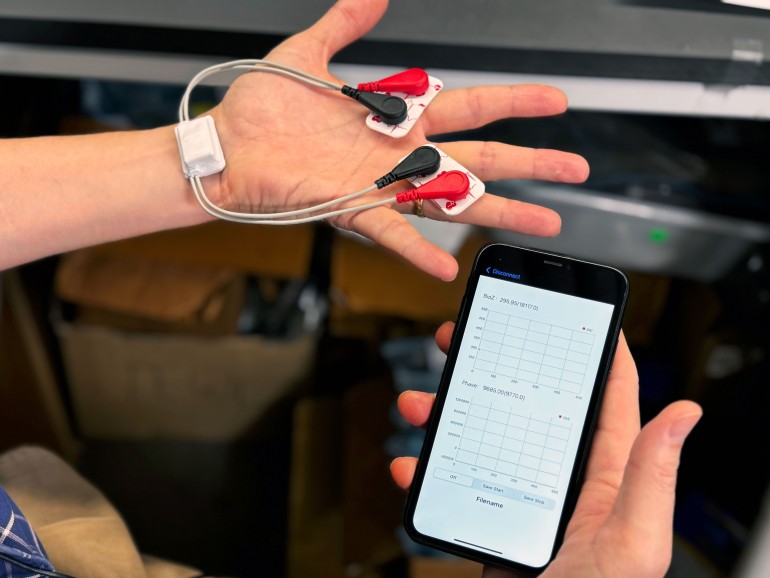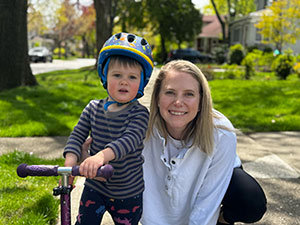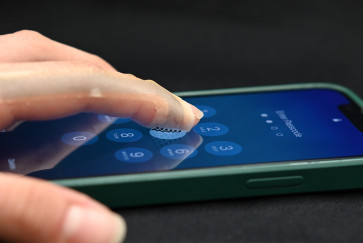While breastfeeding has many benefits for a parent and their baby, it has one major drawback: It’s incredibly difficult to know how much milk the baby is consuming.
To take the guesswork out of breastfeeding, an interdisciplinary team of engineers, neonatologists and pediatricians at Northwestern University has developed a new wearable device that can provide clinical-grade, continuous monitoring of breast milk consumption.
The unobtrusive device softly and comfortably wraps around the breast of a nursing parent during breastfeeding and wirelessly transmits data to a smartphone or tablet. Parents can then view a live graphical display of how much milk their baby has consumed in real time.
By eliminating uncertainty, the device can provide peace of mind for parents during their baby’s first days and weeks. In particular, the new technology could help reduce parental anxiety and improve clinical management of nutrition for vulnerable babies in the neonatal intensive care unit (NICU).
The study was published today (May 14) in the journal Nature Biomedical Engineering. To ensure its accuracy and practicality, the device endured several stages of rigorous assessments, including theoretical modeling, benchtop experiments and testing on a cohort of new mothers in the hospital.
“Knowing exactly how much milk an infant is receiving during breastfeeding has long been a challenge for both parents and healthcare providers,” said Northwestern’s John A. Rogers, who led the device development. “This technology eliminates that uncertainty, offering a convenient and reliable way to monitor milk intake in real time, whether in the hospital or at home.”
“Uncertainty around whether an infant is getting sufficient nutrition can cause stress for families, especially for breastfeeding mothers with preterm infants in the NICU,” said Dr. Daniel Robinson, a Northwestern Medicine neonatologist and co-corresponding author of the study. “Currently, only cumbersome ways exist for measuring how much milk a baby has consumed during breastfeeding, such as weighing the baby before and after they have fed. We expect this sensor to be a big advance in lactation support, reducing stress for families and increasing certainty for clinicians as infants make progress with breastfeeding but still need nutritional support. Reducing uncertainty and helping families achieve their breastfeeding goals will lead to healthier children, healthier mothers and healthier communities.”
A bioelectronics pioneer, Rogers is the Louis Simpson and Kimberly Querrey Professor of Materials Science and Engineering, Biomedical Engineering and Neurological Surgery at Northwestern — where he has appointments in the McCormick School of Engineering and Feinberg School of Medicine — and the director of the Querrey Simpson Institute for Bioelectronics (QSIB). Robinson is an associate professor of pediatrics at Feinberg and an attending physician in the division of neonatology at Ann & Robert H. Lurie Children’s Hospital of Chicago. Rogers and Robinson co-led the study with Dr. Craig Garfield, a professor of pediatrics at Feinberg and attending physician at Lurie Children’s, and Dr. Jennifer Wicks, a pediatrician at Lurie Children’s.
Three postdoctoral researchers at QSIB contributed equally to the project, each of whom is now a faculty member in Korea: Jiyhe Kim, an assistant professor at Ajou University, led the device design and supported clinical trials; Seyong Oh, an assistant professor at Hanyang University, engineered the wireless electronics; and Jae-Young Yoo, an assistant professor at Sungkyunkwan University, developed methods for data analytics. Kim and Oh are co-first authors with Raudel Avila, an assistant professor of mechanical engineering at Rice University and Northwestern Ph.D. graduate, who led the computational modeling.
Addressing an unmet need
The project started four years ago, when neonatologists and pediatricians at Lurie Children’s approached Rogers’ team with a critical unmet need. Because the transfer of milk from parent to baby during breastfeeding is not visible and the flow of milk varies, it’s nearly impossible to know the precise volume of milk a baby consumes in one sitting.
“Currently, there are no reliable ways to know how much babies are eating when they are breastfeeding,” said Wicks, who is a mother of three. “Some pediatricians and lactation consultants will use scales to weigh a baby before and after feeding, and that measurement gives a decent estimate of the amount of milk the baby drank. But unfortunately, baby scales are not small, and most people do not own baby scales. So, while that can provide an estimate, it’s not convenient.”
Currently, there are no reliable ways to know how much babies are eating when they are breastfeeding.”
pediatrician
“There are several advantages to breastfeeding at the breast compared to feeding breast milk with a bottle,” Wicks said. “First and foremost, that skin-to-skin bond is beneficial for both babies and moms. Additionally, milk production is oftentimes stimulated better by actual breastfeeding.”
Although other academic researchers and small startup companies have explored technologies to monitor aspects of breast milk and feeding, peer-reviewed studies are scarce.
“Based on our reviews of the scientific literature and our discussions with pediatricians and neonatologists, there are no clinically validated technologies that address this important medical need,” Rogers said. “Our work fills that gap.”
Pinpointing the right strategy
Rogers’ team previously developed soft, flexible wireless body sensors for monitoring babies in the NICU as well as wearable sensors for tracking the drainage of fluid flow through shunts, which are commonly used to treat patients with hydrocephalus. With experience working with vulnerable populations and developing devices capable of measuring fluid flow, Rogers and his team were ideal candidates for the project.
“Our clinical colleagues asked us whether we could develop a sensor that would allow new mothers to determine how much milk their babies are consuming during a nursing session,” Rogers said. “At first, we weren’t sure how to approach the problem. The strategies we used to track flow through shunts as they pass through locations superficially below the skin don’t work because milk ducts lie too far beneath the skin’s surface.”
After years of failed attempts based on methods to monitor the optical properties of the breast, to quantify suckling motions, to track swallowing events and several others, the engineers finally settled on a remarkably simple technique. The device sends a tiny, safe electrical current through the breast using two small pads, or electrodes, placed on the skin. Another pair of electrodes captures the voltage difference associated with that current.



